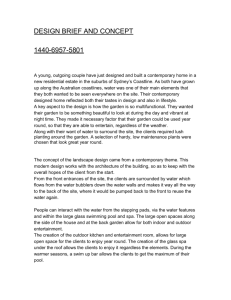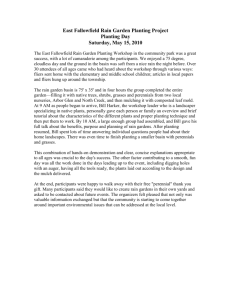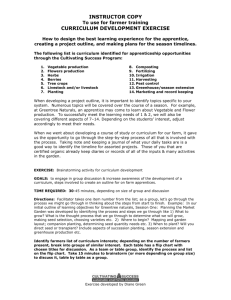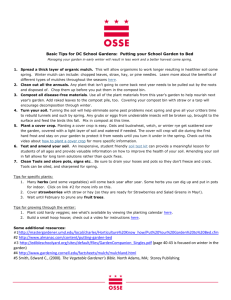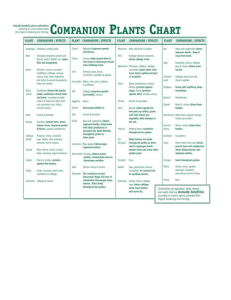Second Grade Projects
advertisement
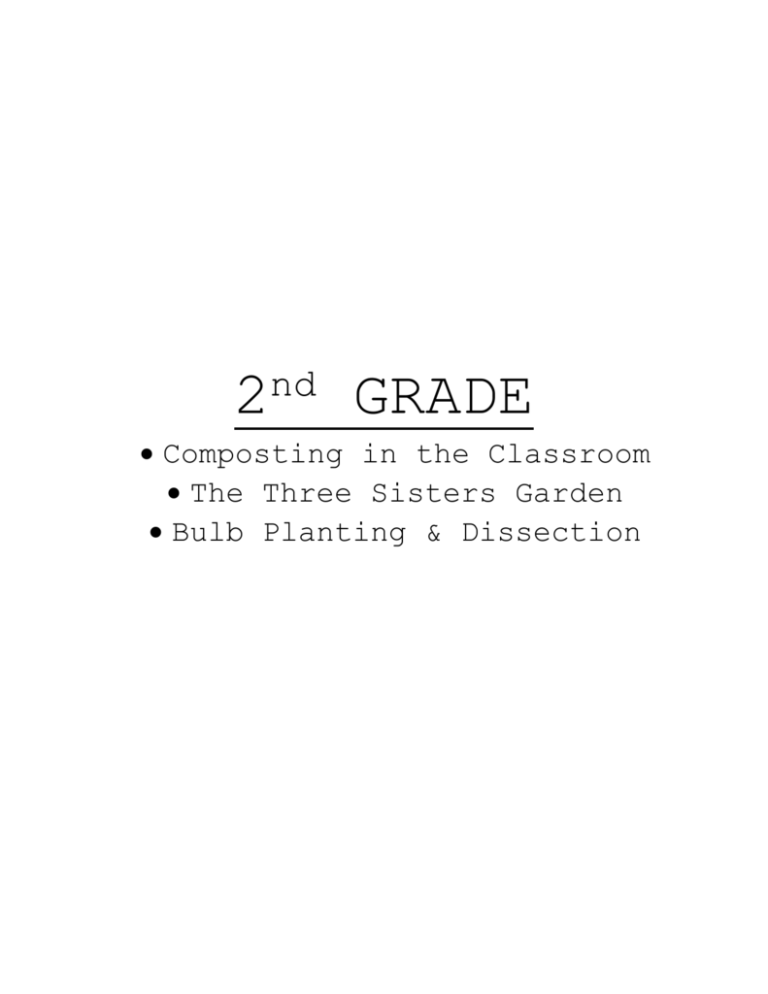
nd 2 GRADE Composting in the Classroom The Three Sisters Garden Bulb Planting & Dissection COMPOSTING IN THE CLASSROOM Grade 2 Introduction: We’d all be knee deep in garbage without decomposition. It is a fundamental process on which all life depends. Composting is a natural process of recycling decomposing organic materials into a rich soil called compost. Composting requires air and rotting material with a balanced nitrogen (green plants) to carbon (tree bark, wood chips) ratio to be successful. Anything that was once living will decompose. Finished compost becomes a great nutrient-rich conditioner for soil in a garden. Objective: In paired groups, students will create their own “compost pile” in the classroom in a quart-sized plastic bag. Materials for each group: One quart-sized bag per student pair A “decay buffet” consisting of organic material with a good nitrogen:carbon ratio (such as fruit peels, vegetable peels, leaves, grass, egg shells, wood chips, leafy greens, newspaper, coffee grounds, tea bags etc.). No meat, bones or fat. 1 cubic foot bag of potting soil 1 large bowl water Several teaspoons for measuring water The “My Compost Pile” worksheet Teacher/parent instructions: Inquiry question – What are organic materials? Read aloud or other multi media reference – Linda Glaser, Compost! – Growing Gardens From Your Garbage, Harlow Rockwell, The Compost Heap Discuss project vocabulary – composting, nitrogen, carbon, decompose, soil, biodegradable, nutrient Project tasks o Willing students elect to bring in a single item for the “decay buffet.” The item should have enough teaspoon-sized servings for each pair. (Students will cut up organic material at home) o Divide class into pairs o Provide each pair with a bag marked with both student’s name on it and the date. o Student’s select items for their bags, a teaspoon at a time, from the “decay buffet” and record them on their worksheets. o Lastly, add ½ cup of soil per bag and 1 teaspoon of water o Blow into the bags to inflate slightly and seal. o Leave bags to decompose for 2-8 weeks. (You may decide to keep the bags together, or place them in various locations with differing conditions) Check bags weekly and record observations o After 2 – 8 weeks of decomposition, the class heads out to the garden to examine the contents of their compost bag and ultimately to add it to the soil in the garden. Possible testable question resulting from this activity: Did all of the organic materials break down at the same rate? Approximate duration of project: “Decay Buffet” and “My Compost Pile” worksheet – 30 minutes per class. Emptying compost into the garden – 10 minutes per class. Approximate time during school year: This project can be done any time of year. THE THREE SISTERS GARDEN Grade 2 Introduction: Eastern Woodland Indians and other northeastern Native American groups planted corn, beans and squash together and named them The Three Sisters. The style of planting that the Indians created, we now call “companion planting.” Companion planting allows plants to assist each other naturally by utilizing the strengths of each plant to make the whole group more successful. In the case of The Three Sisters, the climbing beans will use the corn as a structure to reach the sunlight and the broad leaves of the squash will spread around the base of the planting, keeping moisture from evaporating from the soil and shading out weeds. The squash also deters deer and other pests with its spiny, prickly stalks and leaves. For the Native Americans, The Three Sisters were also helpful for their nutrition. Corn lacks the amino acids (lysine and tryptophan) which the human body needs to make proteins and niacin, but beans contain both of these amino acids and therefore together they provide a balanced diet. Objective: Students will observe the growth of the Three Sisters garden when arriving back to school in the Fall and will plant corn, squash and beans in a Three Sisters formation in the Spring for the following 2nd graders. Materials for each group: 8 Corn seedlings 8 Squash seeds 16 Bean seeds Garden trowels and shovel Tape measure 2 cubic foot bag of potting mix A marker clearly labeled with the teacher’s name and the planting date (a wooden paint stirrer works well). Teacher/parent instructions: Inquiry question – How did companion planting contribute to the health of the Indians as well as the plants themselves? Read aloud or other multi media reference – Joanne Dennee, In the Three Sisters Garden Discuss project vocabulary – companion planting, Woodland Indians, nutrition, seedlings, corn, squash, beans, crops Project tasks o Head out to the school garden bed with the whole class and have the children spread out as much as possible around the planting site. Using the tape measure, trace a 3’ wide circle in the soil. Next, empty the potting mix slowly around the circle, creating a 6” high circular mound of soil. Pat the mound carefully to remove some of the air in it. o Evenly space the corn seedlings around the mound and gently plant them into the mound. o o o Plant a bean seed in the mound on both sides of each corn seedling, leaving a space of about 4”from the corn seedling. Evenly space out the squash seeds in the center of the circle, not getting too close to the corn and plant. Pat down the soil gently over the squash seeds. Water planted area well. Possible testable question resulting from this activity: What are the Three Sisters and how did they help the Indians? Approximate duration of project: Planting time 25 minutes per class. Subsequent visits to the garden for viewing 5 minutes Approximate time during school year: The Three Sisters planting would be done just after Mother’s Day (early May – after the danger of last frost). In the fall, when the students return to school, the teacher could take his/her new class out to view the end result of The Three Sisters so that they would be able to appreciate the planting they would undertake that spring. QuickTime™ and a decompressor are needed to see this picture. THE THREE SISTERS GARDEN PLANTING GUIDE The traditional Three Sisters plan is a circle with squash on the outside with corn and beans rotating on the inside in a mound, similar to Diagram #3 with squash encircling it. But here are 2 gardening plans to meet our square and rectangle conventional beds, the squash is on the outside of the bed while the corn and beans are dispersed between each other. QuickTime™ and a decompressor are needed to see this picture. QuickTime™ and a decompressor are needed to see this picture. BULB PLANTING AND DISSECTION Grade 2 Introduction: Plants are made up of many parts consisting of a flower, bud, root, fruit, leaf and stem. Each of these parts has an important specific function in the development and well being of a healthy, productive plant. All plants have particular requirements for growth such as sunshine (photosynthesis), water and minerals and nutrients found in soil. Objective: In order to study the parts of a plant and the natural requirements necessary for a plant to thrive, students will plant a tulip or daffodil bulb in a specified garden site in autumn. They will harvest the bulbs in the spring and ultimately dissect the flowers produced by the bulbs. Materials for each group: One tulip or daffodil bulb per student Several garden trowels (children take turns) A prepared, fertile soil plot A marker to define the area used by each class (wooden paint stirrers work well) labeled with the teacher’s name and planting date Gardening gloves (optional) A ruler Cutting board and sharp knife (for bulb dissection) The worksheet entitled “Observing Bulbs” The worksheet entitled “Parts of a Plant” Teacher/parent instructions: Inquiry question – What are the requirements of a plant? Read aloud or other multi media reference –Tulips by John F. Provost, Planting a Rainbow by Lois Ehlert, From Seed to Plant by Gail Gibbons and Green and Growing by Susan Blackaby Discuss project vocabulary – Bulbs, soil, photosynthesis, parts of a plant (root, stem, flower, bud, leaf, fruit) Project tasks o First, bulbs are delivered to each teacher a week in advance of planting in order for the students to observe the bulb. o A week later, head out to the garden with either the whole class or smaller groups to plant. Start at the farthest, hardest to reach part of the planting site and dig a straight, narrow trench coming forward to the front of the planting bed. The trench should be at least 8” deep (a student can measure with the ruler) and should be wide enough to easily snuggle a bulb into the earth. o Have students line up, bulb in hand, to plant. Place the bulbs single file in the trench, starting at the back and working forward (it doesn’t matter if they’re o o o touching). Fill in the trench, covering the bulbs and pat down gently. Make as many trenches as needed (usually 3 is enough per class). Place the wooden marker in the soil at the site. In March, several or all of the bulbs can be harvested by a parent volunteer and then washed off and cut open for observation of the parts of the plant. After harvesting a number of flowering bulbs in the spring (March) the class can fill out the “Observing Bulbs” and “Parts of a Plant” worksheets. Possible testable question resulting from this activity: What supplies the energy to the bulbs? What makes them start to grow in the spring? Approximate duration of project: Planting – 25 minutes per class. Completing worksheets – 25 minutes total. Approximate time during school year: Bulbs should be planted the last week in October (one week before or after is fine too). Harvesting the flowers and subsequent classroom discussion should take place in early spring (March). Different varieties of bulbs will emerge at different times and there’s a long window of opportunity. QuickTime™ and a decompressor are needed to see this picture. OBSERVING BULBS WORKSHEET Use your senses to observe your bulb. what it looks like. Draw and describe My bulb is a __________________________________ It looks like: Draw it: It smells like: It feels like: Use your notes to write a description of the bulb:
